Practice Question - 8 (Chart) | 100 DILR Questions for CAT Preparation PDF Download
The chart below provides complete information about the number of countries visited by Dheeraj, Samantha and Nitesh, in Asia, Europe and the rest of the world (ROW).
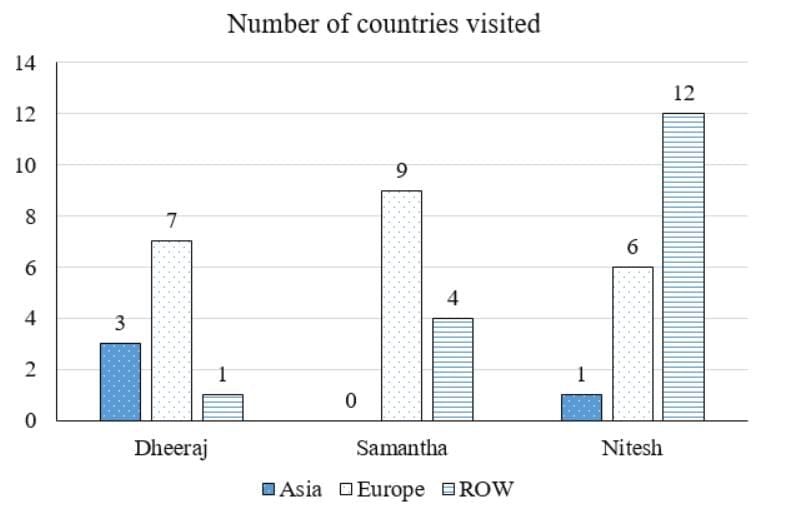
The following additional facts are known about the countries visited by them.
1. 32 countries were visited by at least one of them.
2. USA (in ROW) is the only country that was visited by all three of them.
3. China (in Asia) is the only country that was visited by both Dheeraj and Nitesh, but not by Samantha.
4. France (in Europe) is the only country outside Asia, which was visited by both Dheeraj and Samantha, but not by Nitesh.
5. Half of the countries visited by both Samantha and Nitesh are in Europe.
Q1: How many countries in Asia were visited by at least one of Dheeraj, Samantha and Nitesh?
 View Answer
View Answer 
Ans: 3
Writing down the data with us in a table form. 
But this includes countries which have been visited by one person, two people and three people. Essentially, there is an overlap of countries.
It is given to us that 32 distinct countries were visited among the three people,
Using that we can write down the equations,
I + II + III = 32...(1)
I + 2II + 3III = 43...(2)
Where I, II, and III denote the number of countries visited exactly by 1 of them, 2 of them and all of them.
We are told that USA(ROW) is the only country which was visited by all three people, that means III = 1
Subtracting Equation 1 from 2 we get, II + 2III = 11
And since III = 1 we get II = 9
So, we are looking for 9 countries visited by exactly 2 people, and 22 countries visited by exactly 1 person.
Using the information from the problem set, we can note down the following,
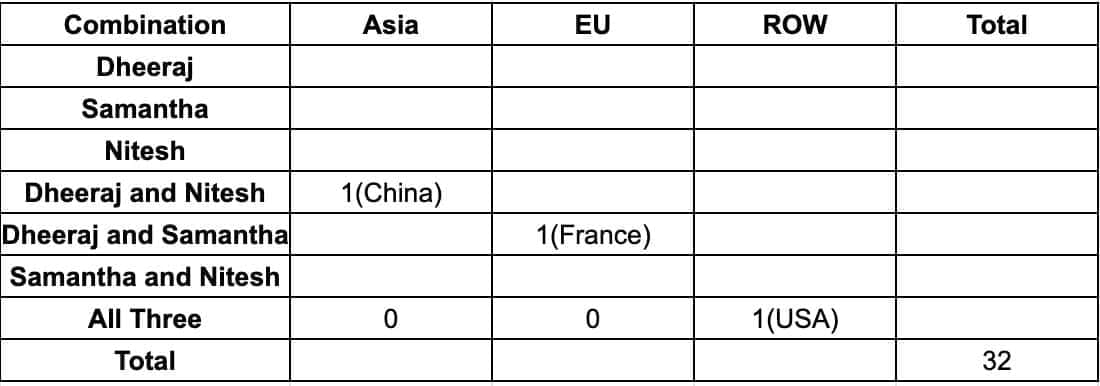
We can see that Dheeraj visited only 1 country in ROW so every other value in that column has to be zero for wherever Nitesh is present. And Samantha has not visited any country in Asia so every value with Samantha present in Asia should be zero as well.
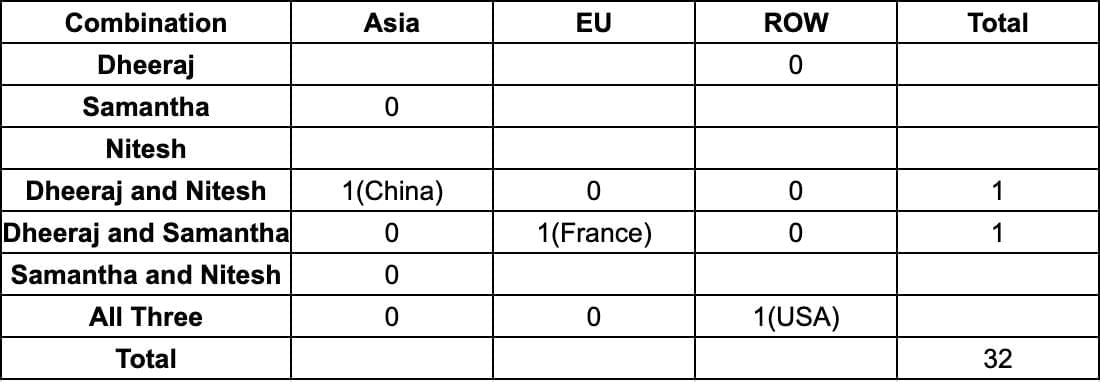
We have the following distribution, we are looking for 9 countries visited by exactly 2 people. And we have identified 2 countries, that means, 7 were countries were visited by both Samantha and Nitesh only. And given that half the countries visited by both of them are in Europe, and total number of countries visited by both of them is 7(only two of them)+1(USA)=8, they visited 4 countries in Europe together and 3 countries in ROW together. And using that information, we can fill in the rest of the table as well. Since we know the number of countries visited by each of them in a particular continent. 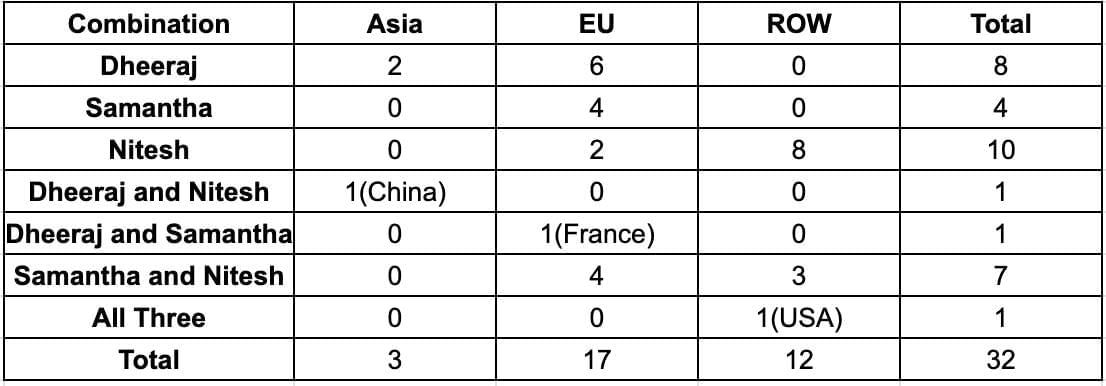
How many countries in Asia were visited by at least one of Dheeraj, Samantha and Nitesh is 3.
Q2: How many countries in Europe were visited only by Nitesh?
 View Answer
View Answer 
Ans: 2
Writing down the data with us in a table form. 
But this includes countries which have been visited by one person, two people and three people. Essentially, there is an overlap of countries.
It is given to us that 32 distinct countries were visited among the three people,
Using that we can write down the equations,
I + II + III = 32...(1)
I + 2II + 3III = 43....(2)
Where I, II, and III denote the number of countries visited exactly by 1 of them, 2 of them and all of them.
We are told that USA(ROW) is the only country which was visited by all three people, that means III = 1
Subtracting Equation 1 from 2 we get, II + 2III = 11
And since III = 1 we get II = 9
So, we are looking for 9 countries visited by exactly 2 people, and 22 countries visited by exactly 1 person.
Using the information from the problem set, we can note down the following, 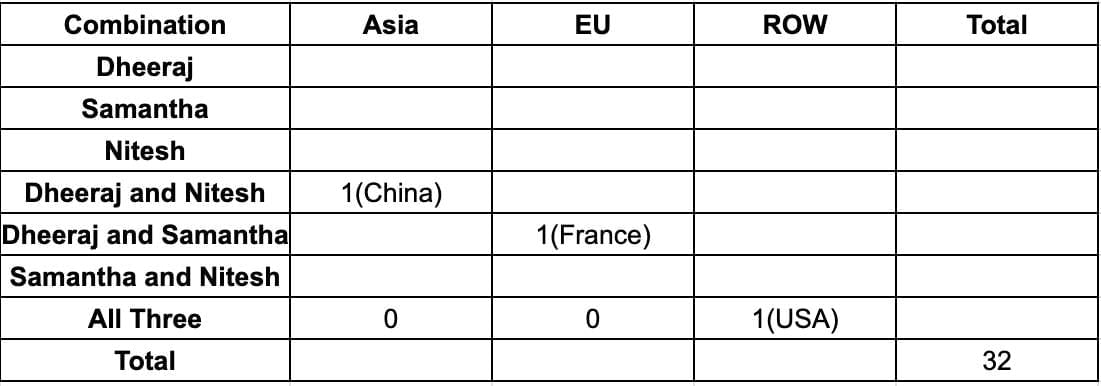
We can see that Dheeraj visited only 1 country in ROW so every other value in that column has to be zero for wherever Nitesh is present. And Samantha has not visited any country in Asia so every value with Samantha present in Asia should be zero as well.
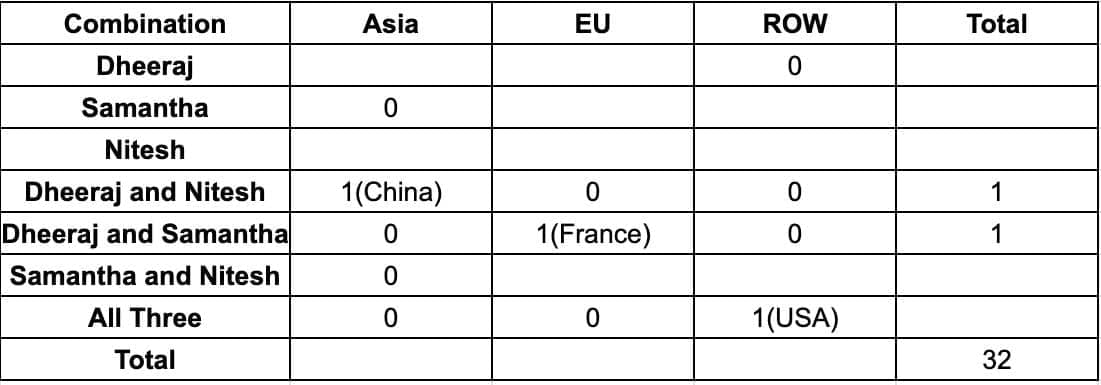
We have the following distribution, we are looking for 9 countries visited by exactly 2 people. And we have identified 2 countries, that means, 7 were countries were visited by both Samantha and Nitesh only. And given that half the countries visited by both of them are in Europe, and total number of countries visited by both of them is 7(only two of them)+1(USA)=8, they visited 4 countries in Europe together and 3 countries in ROW together. And using that information, we can fill in the rest of the table as well. Since we know the number of countries visited by each of them in a particular continent. 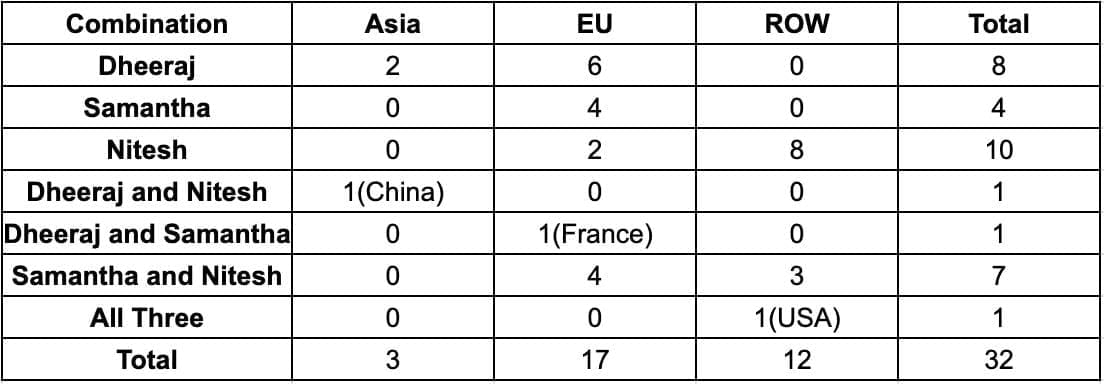
Number of countries visited by only Nitesh is 2.
Q3: How many countries in the ROW were visited by both Nitesh and Samantha?
 View Answer
View Answer 
Ans: 4
Writing down the data with us in a table form.

But this includes countries which have been visited by one person, two people and three people. Essentially, there is an overlap of countries.
It is given to us that 32 distinct countries were visited among the three people,
Using that we can write down the equations,
I + II + III = 32...(1)
I + 2II + 3III = 43...(2)
Where I, II, and III denote the number of countries visited exactly by 1 of them, 2 of them and all of them.
We are told that USA(ROW) is the only country which was visited by all three people, that means III = 1
Subtracting Equation 1 from 2 we get, II + 2III = 11
And since III = 1 we get II = 9
So, we are looking for 9 countries visited by exactly 2 people, and 22 countries visited by exactly 1 person.
Using the information from the problem set, we can note down the following,
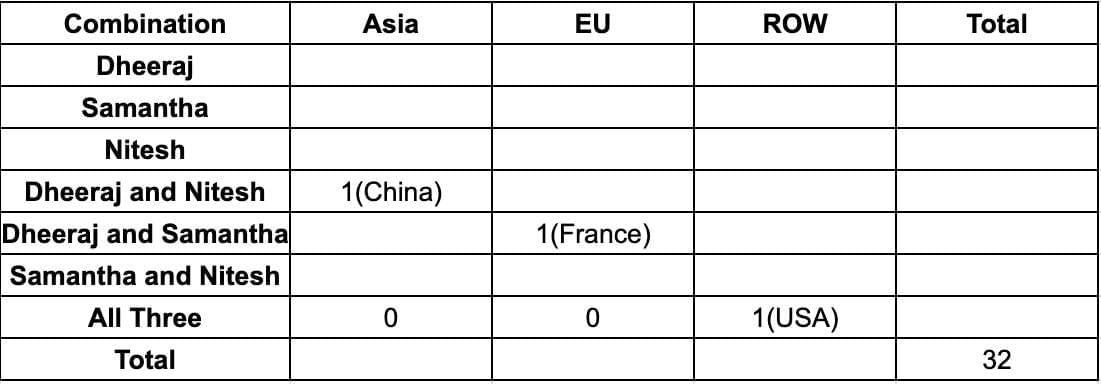
We can see that Dheeraj visited only 1 country in ROW so every other value in that column has to be zero for wherever Nitesh is present. And Samantha has not visited any country in Asia so every value with Samantha present in Asia should be zero as well.
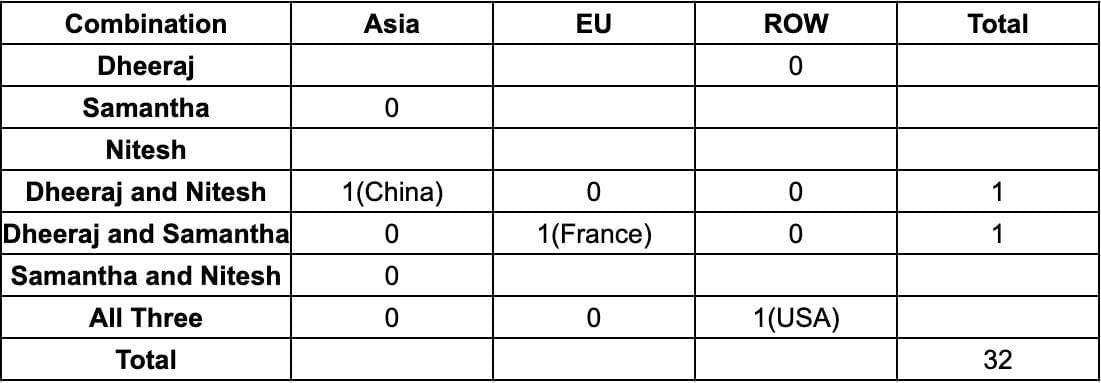
We have the following distribution, we are looking for 9 countries visited by exactly 2 people. And we have identified 2 countries, that means, 7 were countries were visited by both Samantha and Nitesh only. And given that half the countries visited by both of them are in Europe, and total number of countries visited by both of them is 7(only two of them)+1(USA)=8, they visited 4 countries in Europe together and 3 countries in ROW together. And using that information, we can fill in the rest of the table as well. Since we know the number of countries visited by each of them in a particular continent.
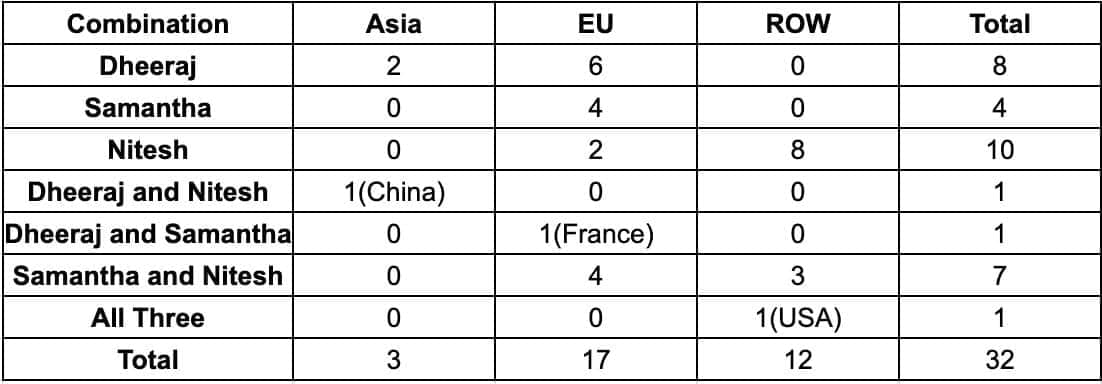
Number of countries in ROW visited by both Nitesh and Samantha is 3 + 1 = 4.
Q4: How many countries in Europe were visited by exactly one of Dheeraj, Samantha and Nitesh?
(a) 10
(b) 5
(c) 14
(d) 12
 View Answer
View Answer 
Ans: (d)
Writing down the data with us in a table form. 
But this includes countries which have been visited by one person, two people and three people. Essentially, there is an overlap of countries.
It is given to us that 32 distinct countries were visited among the three people,
Using that we can write down the equations,
I + II + III = 32...(1)
I + 2II + 3III = 43...(2)
Where I, II, and III denote the number of countries visited exactly by 1 of them, 2 of them and all of them.
We are told that USA(ROW) is the only country which was visited by all three people, that means III = 1
Subtracting Equation 1 from 2 we get, II + 2III = 11
And since III = 1 we get II=9
So, we are looking for 9 countries visited by exactly 2 people, and 22 countries visited by exactly 1 person.
Using the information from the problem set, we can note down the following,
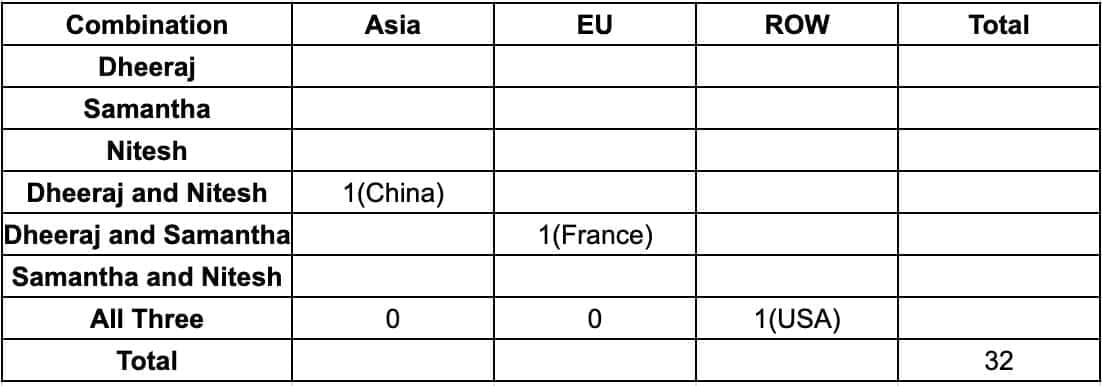
We can see that Dheeraj visited only 1 country in ROW so every other value in that column has to be zero for wherever Nitesh is present. And Samantha has not visited any country in Asia so every value with Samantha present in Asia should be zero as well.
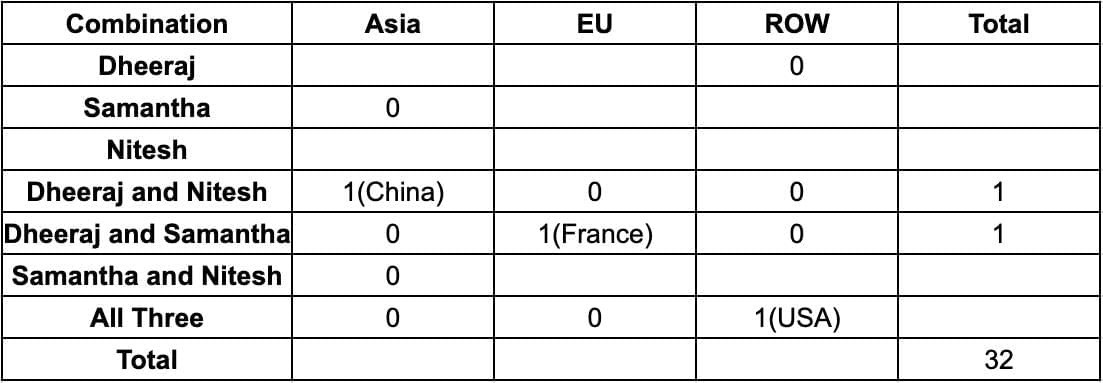
We have the following distribution, we are looking for 9 countries visited by exactly 2 people. And we have identified 2 countries, that means, 7 were countries were visited by both Samantha and Nitesh only. And given that half the countries visited by both of them are in Europe, and total number of countries visited by both of them is 7(only two of them)+1(USA)=8, they visited 4 countries in Europe together and 3 countries in ROW together. And using that information, we can fill in the rest of the table as well. Since we know the number of countries visited by each of them in a particular continent.
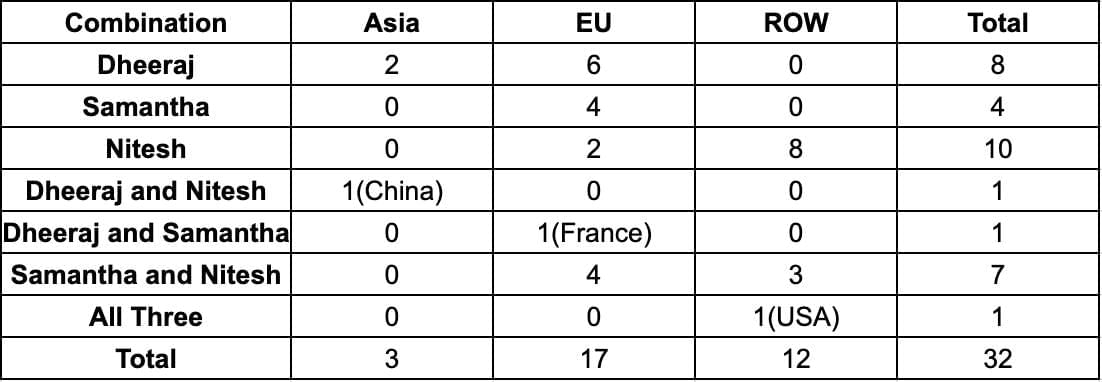
Number of countries in EU visited by exactly 1 person is 12.
|
102 videos|123 docs|121 tests
|
FAQs on Practice Question - 8 (Chart) - 100 DILR Questions for CAT Preparation
| 1. What is the significance of chart-based questions in the CAT exam? |  |
| 2. How can candidates effectively prepare for chart-based questions in the CAT exam? |  |
| 3. What types of charts are commonly used in the CAT exam for data interpretation? |  |
| 4. Are there any specific strategies to tackle complex chart-based questions in the CAT exam? |  |
| 5. How important is time management when answering chart-based questions in the CAT exam? |  |





















